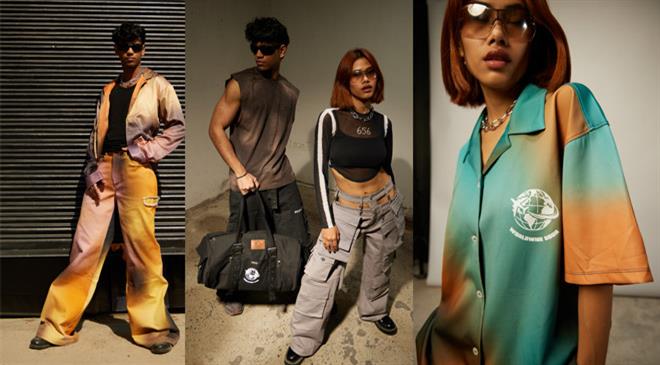
Avni Aneja
Co-Founder
Brand - Six5Six
People who wear our pieces feel like they belong somewhere
The fashion brainchild of brother-sister duo Avni Aneja and Ambar Aneja, Six5Six has been steadily making its mark in the streetwear scene in India. In a chat with Fibre2Fashion, Avni Aneja talks about the challenges faced by the sports and streetwear brand, its ethical practices, and how it resonates with diverse people.
Fibre2Fashion: What inspired you to create the Six5Six streetwear brand and what does the brand represent?
Avni Aneja:
Six5Six is primarily a sportswear/sports goods brand that we conceptualised in 2019. Both Ambar and I had just come back from LA and London, respectively, and had gained some knowledge of as well as interest in streetwear culture. We wanted to turn this passion into something bigger and that is how we started Six5Six Street in 2019 with a small capsule collection of 10 pieces. The brand represents everything that we think and experience in our everyday life through clothes and fashion.
F2F: How do you incorporate culture, thoughts, expressions, and music into your designs?
AA:
When we started Six5Six Street, there were barely any streetwear brands in the Indian scene at that time. We believed that what we thought, felt, and wanted to show wasn’t adequately represented. For example, our first capsule was called The Global Traveller. It was the time when there was a migration crisis across the world and that was something we felt passionately about as we considered ourselves global citizens. Our second drop was called Humanity In The Digital Age, which is sort of self-explanatory. We wanted to show how our lives are ruled by technology and how dependent we are on it. The way we like to represent these thoughts is through subtle textual references that we know would transcend boundaries and cultures and aren’t confined to just India or a singular country/community. Every drop we work on is a conversation starter and has something that we have been thinking about for ages and deem valuable enough to share with our peers.
F2F: As a fashion brand that represents the new India, what message do you hope to convey through your clothing?
AA:
I think fashion is very personal and we don’t want to convey any specific message as such, but I hope anyone who wants to wear any of our pieces, wears them without thinking about what anyone would think—no matter their age, sex, religion, orientation etc. Everyone is welcome at Six5Six.
F2F: How does Six5Six Street challenge the norms of the fashion industry, and what sets it apart from other fashion brands?
AA:
We’re trying to produce something meaningful, something that is based on community and not just the fashion trends of today. People who wear our pieces feel like they belong somewhere, and it is an accepting and welcoming space. On the technical side, we produce all our pieces ethically and in small batches with a lot of upcycled and dead stock fabrics for mindful consumption. We’re also size inclusive and completely unisex.
F2F: Can you discuss some of the challenges you faced while starting the brand, and how did you overcome them?
AA:
Like I said before, we were one of the first few streetwear brands in India. So, to make people understand the concept of streetwear was our first challenge. Not everyone understood what we were making and why, so before sales we had to educate people. Also, since we don’t produce fast fashion and produce ethically and in small quantities, people had complaints about our prices, often comparing us to the likes of fast fashion brands. People have been more accepting now once they’ve tried our products and can feel the difference in quality, but it was quite a challenge in the beginning.
F2F: Sustainability and ethical production are becoming increasingly important in the fashion industry. How do you prioritise sustainability and ethical practices in your production processes?
AA:
Sustainability is an umbrella term; so, we stay away from using that particular word because of its current usage in the fashion industry. A lot of greenwashing is done under the garb of sustainability by brands of all stature—fast fashion to even luxury. However, we have our own small manufacturing unit with a team of tailors, masters, and pattern makers who are paid fair wages, have medical insurance, and are taken care of directly by both Ambar and me. We also produce only quantities that we require, using deadstock fabrics, upcycle pieces that are leftover in stock, and use only local fabrics and techniques to create our products.
F2F: How does Six5Six Street keep up with the latest fashion trends while maintaining its unique identity and staying true to its values?
AA:
The only way to stay true to our values and identity is in fact by NOT following trends. We try to make pieces that will last a lifetime, both in terms of design as well as quality. Trends come and go, and we didn’t want to make anything that goes out of style after a season or two.
F2F: How has the brand evolved since its inception? What are your plans for its future growth and development?
AA:
We’ve been able to build a growing community and have had people come and appreciate our work and tell us that they’ve been following us since the very beginning. I think that’s been one of the best parts of the job. The brand has grown up with us which is visible in our design language as well as quality control. Since it’s a very personal brand, it will continue to grow with us.
F2F: Can you talk about any collaborations or partnerships that your brand has been involved in and how have they impacted the brand?
AA:
Collaborations are fun only if they make sense. A few years ago, collaborations used to be meaningful; bringing brands with different audiences and matching synergies together to create something unique. Currently, they’ve become very profit driven. We haven’t done too many collaborations as of now, but we intend to work only with brands, artists, musicians, and people that resonate with us and a partnership that would be prove beneficial to us, our collaborators, and most importantly our community.
F2F: Can you suggest five streetwear trends that every fashion enthusiast should know?
AA:
Streetwear is not about trends; that’s the first thing that fashion enthusiasts should know. Historically, streetwear has been associated with hip hop music, surf and skate culture, sportswear, and graffiti art among other things. Oversized denims and graphic tees are some staple pieces that have stayed in streetwear.

Rahul Mehta
Gabi Seligsohn
Abhay Gupta
Fanny Vermandel
Arun Sirdeshmukh
Bill D’Arienzo
Aseem Prakash
Anurag Batra
Rahul Mehta
Pradip Mehta


20230103183907.png)








_8.JPG)

